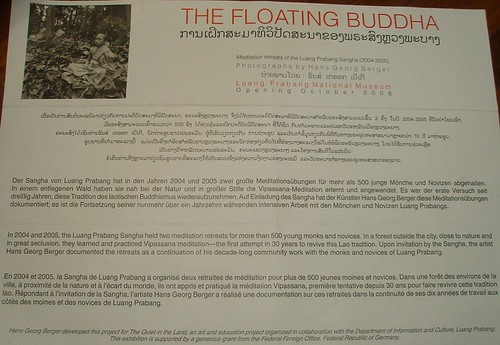Two of the works touched upon the practice of vipassana meditation - Hans Georg Berger's The Floating Buddha, & Ann Hamilton's The Story of the Meditation Boat. The former is a photographic documentation of the first two vipassana meditation training retreats of the Luang Prabang sangha, held in 2004 & 2005 at Wat Pa Phon Phao. At present such training retreats continue to be held there during the cold season for monks & novices in their final year of high school, where they are taught how to meditate in the four postures - sitting, standing, walking & lying down. Over in Vientiane capital, such training retreats are held at Wat Dongsavath for monk & novice students of the Sangha College, while vipassana lessons open to tourists are at Wat Sok Pa Luang, & an intrepid few have found their way to Wat Nakhoun Noi (contact info).
Most of the students grew up in rural villages, & by all accounts enjoy the forest setting of the retreats at Wat Pa Phon Phao, an interesting break from the four walls of their classrooms. Walking barefooted along the trails is exactly what they did as kids, although shooting birds with catapults & digging up mushrooms & bamboo shoots for dinner - & the whole idea of dinner itself - were definitely off the agenda in this context. Two years later, a consultant who had since returned to lay life would whisk the cat off on his motorbike for a surprise visit to this temple to relive fond memories of his high school days.
Four temples - ວັດຫາດສ້ຽວ Wat Hat Seo, ວັດຄົກປາບ Wat Khok Pap, ວັດລ້ອງຄູນ Wat Long Khoun & ວັດໂຄມຂວາງ Wat Khom Khouang - in Luang Prabang each have a long, narrow window-less building. Much like a bare, enclosed corridor, it is used for the practice of walking meditation, or what might appear to onlookers as a slow, complicated way of pacing up & down with a patience quite unassociated with pacing up & down. The Story of the Meditation Boat floated the practice of vipassana meditation in a most literal sense, by constructing a similar structure for the same purpose, but on a boat rather than on solid ground. No idea if the boat is to be used while moored or while travelling...given how each step is broken down into six component movements, practising walking meditation on a moving boat might involve taking it to a higher level of accomplishment - maintaining one's balance on top of remaining focused on every movement...
Exhibition leaflet from The Floating Buddha:

Click here for larger version
Folded into thirds lengthwise, the A4-sized leaflet was like a modern take on the traditional palm leaf manucripts on which scriptures were recorded for centuries before the printing press was invented. Originating in India, this practice spread across Asia to Sri Lanka, Nepal, Bali, Xishuangbanna (Sipsongpanna, Yunnan), Thailand, Burma, Laos, & Cambodia. In addition to scriptures & jatakas (stories of the past lives of the Buddha), information on disciplines as diverse as rituals & ceremonies, art, dance, music, architecture, medicine, science, agriculture, astronomy, astrology, yoga, martial arts, law, history & economics was also recorded onto such manuscripts by first etching words & drawings onto the treated leaves with a sharp metal stylus, & then rubbing them with pigments made from the soot of oil lamps & various plant extracts to give the engravings colour. What may be summed up as an extremely laborious process of preparing beautiful termite food (which is in itself a lesson in impermanence)...

No comments:
Post a Comment